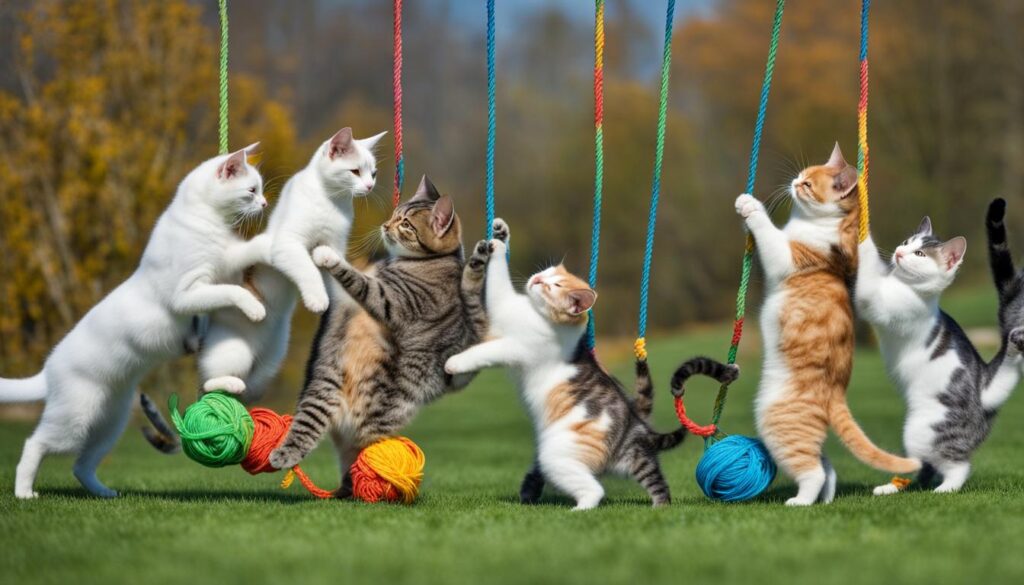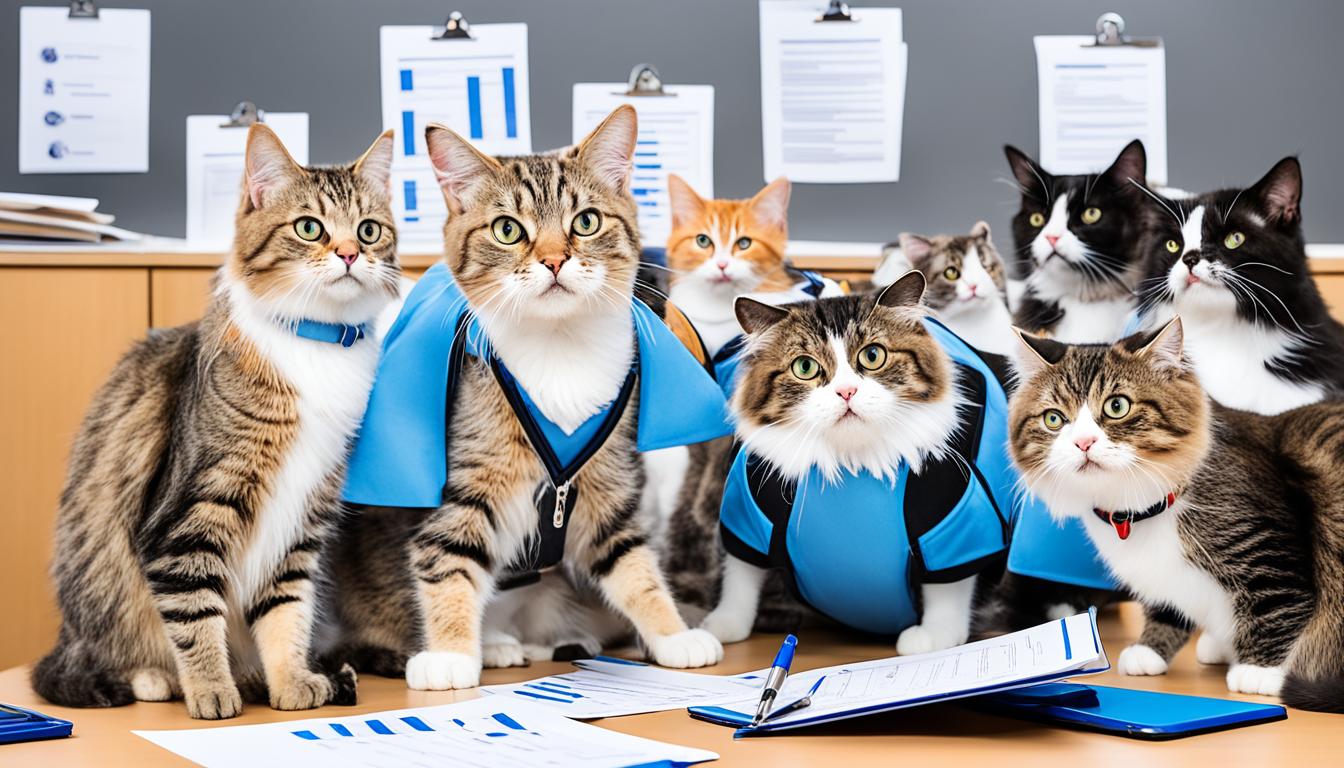As an Amazon Associate I earn from qualifying purchases.
Have you ever felt like you’re trying to stop the wind? Or make the ocean’s waves stand still? That’s what it’s like to herd cats. In leadership, teamwork, or project management, it’s more about finesse than force.
Herding cats is a funny way to describe getting people to work towards the same goal. It shows how leadership needs patience, insight, and innovation. When you try to coordinate a team, you see that with understanding and guidance, things can work. Leaders must know how to unite diverse talents.
Key Takeaways
- Appreciate ‘herding cats’ as a metaphor for managing complex team dynamics in project management.
- Recognize the importance of patience and innovation in tackling leadership challenges.
- Understand that successful teamwork coordination hinges on the harmony of diverse strengths.
- Adopt organizational skills that facilitate guidance rather than imposition.
- Learn strategies to influence individual team members toward achieving common goals.
Understanding the Complexity of Cat Herding
Managing tasks that feel as chaotic as herding cats can be tough. It’s like trying to lead a team where everyone has their own ideas and ways of doing things. Imagine working on software or getting a group to change, and it’s like each person is a cat – unpredictable. This may sound funny, but it’s a real test of your skills in leading and managing.
Having good communication strategies is key in these situations. It’s how you connect with a group that likes to do their own thing. Whether you’re working with tech experts or teaching students, the aim is to get everyone on the same page. You want to use the group’s strengths without making anyone feel lost.
Here are some ways to better handle the unpredictability of herding ‘cats’:
- Develop a leadership style that shifts as needed for your team.
- Use different ways to talk and listen that match what each person needs, but still help everyone work together.
- When things seem messy, break jobs down into smaller, clear tasks.
Leadership is about guiding without controlling. This lets each ‘cat’ show their best while following the path you set. Being patient and strategic can turn seemingly impossible tasks into achievements.
Establishing Clear Boundaries and Expectations
When dealing with leadership challenges, it’s vital to outline your goals clearly. You should also define what’s not allowed. This helps guide your team through their tasks and projects. Think of it as setting up posts to keep everyone on the right path.
Creating an Organized Framework
The first step is creating an organized framework. It’s a base that supports all future actions and decisions. It’s key for teamwork coordination and ensures everyone knows their role. It also shows them how to do their jobs without confusion.
Setting Achievable Goals
Goals fuel every project. In communication strategies, setting clear goals makes a leader stand out. Tie your team’s strengths to the group’s mission by setting achievable goals. This boosts everyone’s performance. It also strengthens the team’s unified effort to reach those goals. A clear goal is essential for great organizational skills.
The Art of Influencing Without Overpowering
To lead effectively in project management, it’s key to go beyond directing. You need to inspire. Understanding how to balance individual freedom with team goals is crucial. We’ll delve into how to maintain this balance.
Start by using motivational language. Know your team like a seasoned salesperson knows their client. Encourage them. You want them to aim higher and expand their skills. This method gently leads them towards outstanding performance and is vital for teamwork coordination.
“Leadership is not wielding authority- it’s empowering people.” – Becky Brodin
Praise team members publicly and offer constructive criticism in private. This approach not only acknowledges their hard work but keeps them focused on team goals. A leader’s success is measured by both the project’s outcome and the team’s achievements.
- Utilize motivational language that encourages and challenges
- Offer public praise to acknowledge and motivate
- Provide constructive criticism privately to foster improvement
It’s also important to balance acknowledging both effort and results. Valuing your team’s hard work can create a more engaged and committed team. This is essential for combining project management with strong team dynamics.

In today’s fast-paced work environments, using these strategies can make a big difference. It helps you master the art of influence without being too controlling. This approach prepares your team for current and future success, giving them confidence and skill.
Herding Cats: Cultivating a Team Dynamics
Leadership challenges bring the idea of herding cats to life. It requires finesse and understanding to create a team that doesn’t just work together, but excels. By nurturing cooperation and celebrating strengths, a dynamic team atmosphere can be fostered.
Nurturing Cooperative Teamwork
Trust and respect are vital when teamwork is essential. It’s all about making everyone feel a part of the team’s success. Encourage open talks and collaboration to build a cooperative spirit.
Celebrating Individual Strengths
When teams honor each member’s talents, handling tough tasks becomes easier. Praising individual efforts boosts morale and the team’s overall success. Employing a variety of skills can greatly help in tackling complex projects.
| Team Building Activity | Cooperation Boost | Strength Spotlight |
|---|---|---|
| Cross-Functional Workshops | Encourages interdepartmental teamwork | Highlights multidisciplinary expertise |
| Peer Recognition Programs | Builds a culture of mutual support | Shines a light on individual achievements |
| Team Challenges | Promotes solving problems together | Demonstrates adaptability and creativity |
By applying these methods, you tackle leadership challenges and make task management a team effort. This confirms that a team is truly greater than its parts.

The secret to effective cat-herding is to value each member and their contributions. This creates a team that’s resilient, adaptable, and coordinated in its efforts.
Leadership Techniques that Encourage Self-Management
In an environment full of leadership challenges, teaching teams to self-manage is key. It’s essential for success. Helping team members tackle managing difficult tasks on their own boosts productivity. It also sparks innovation. Leaders must use certain tactics to let individuals thrive in such environments.
To instill organizational skills, start by trusting your team. When they feel trusted, they’re more likely to take the lead. This trust encourages them to manage themselves. It allows for a flexible team that meets challenges head-on.
- Highlight the connection between autonomy and team members’ personal sense of achievement.
- Develop transparent communication channels to ensure clarity in expectations and goals.
- Offer regular feedback that balances constructive criticism with public recognition.
Leaders should offer guidance and support with managing difficult tasks, not command every action. This way, team members use their insights to find better solutions. It results in innovative thinking and better results. Leaders must strike the right balance between giving freedom and guiding when necessary.
Remember, responsible autonomy comes with understanding the importance of shared goals and the broader impact of one’s work on the organization’s mission.
Here’s how different leadership styles can encourage self-management:
| Leadership Style | Promotes Self-Management By | Suitable For |
|---|---|---|
| Democratic | Encouraging group decision-making and active participation. | Early-stage project development. |
| Transformational | Inspiring through vision and personal influence. | Times of organizational change. |
| Coaching | Focusing on individual growth and longer-term success. | Developing future leaders or specialists. |
| Transactional | Clarifying roles and task requirements, providing rewards for achievements. | Routine and goal-specific tasks. |
To wrap things up, using these leadership styles helps team members with organizational skills and leadership challenges. They become better at managing difficult tasks. The aim is to create a place where everyone feels accountable. They will be proud of their contributions. This promotes a culture of productivity, creativity, and self-direction.
Resilience and Adaptability in Cat Herding
In the whirlwind of cat herding, you really need resilience and adaptability. These aren’t just fancy words. They’re key to winning in project management. Leading different groups can feel like a circus.
Embracing and Learning from Chaos
Life’s unpredictability should be faced boldly, not feared. If you’re resilient, you’re ready for any crisis. By embracing chaos, you learn and help your team grow.
This turns chaos into a chance for your team to shine.
Being Agile in Response to Unpredictable Scenarios
Adaptability means being flexible and quick to change. When your project’s ground shifts, knowing how to adapt is vital. An agile team moves like water, perfectly fitting into new shapes.
Everyone shares the responsibility. This makes change something positive, not a problem.
| Strategy | Benefits | Impact on Project Management |
|---|---|---|
| Continuous Learning | Fosters growth mindset | Enhances team capability to tackle complex problems |
| Flexible Planning | Allows for rapid response to changes | Prevents stalled progress and builds team confidence |
| Encouraging Open Communication | Improves collaboration | Strengthens trust and shared understanding |
| Shared Accountability | Promotes ownership and responsibility | Aligns individual goals with the organization’s mission |
Conclusion
Mastering the art of herding cats teaches us about leadership’s complex nature. In project management and team coordination, leaders must learn many skills. They need to set boundaries, influence without controlling, and encourage teamwork. These are essential for both personal and professional growth.
As leaders, you are like orchestra conductors, making sure every part works in harmony. This success requires advanced organizational skills. These skills help align free-spirited professionals with the company’s goals. By valuing self-management, you let each team member excel and contribute to a common goal.
Leading through complex situations calls for resilience and the ability to adapt strategically. These are key for coordinating a team well. With these insights, you’re ready to meet challenges with a positive attitude and lead with integrity. The way you handle unpredictability defines your leadership greatness.
FAQ
What does the term “herding cats” mean in a professional context?
Why is cat herding considered a complex leadership challenge?
What are the first steps in establishing clear boundaries and expectations for a team?
How can a leader influence a team without becoming overbearing?
What methods can be employed to cultivate cooperative teamwork within a team?
How can leadership encourage team members to manage themselves effectively?
What qualities are essential for resilience and adaptability in managing unpredictable tasks?
Why is being agile important when facing unpredictable scenarios in project management?
As an Amazon Associate I earn from qualifying purchases.

